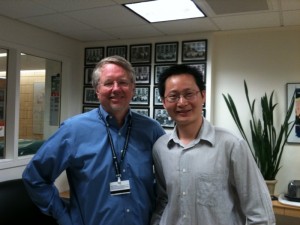2012
Research story of Dr. Long-Jun WU
 Many congratulations to Dr. Long-Jun Wu for publishing a Nature Neuroscience article in March, 2012. Dr. Wu received his PhD degree in School of Life Sciences at University of Science and Technology of China in 2004, supervised by Prof. Tian-Le Xu. From year 2004 to 2008, Dr. Wu did his first postdoctoral training with Prof. Min Zhuo in University of Toronto, Canada. In early 2008, Dr. Wu started his second postdoctoral training with Prof. David Clapham at Children’s Hospital Boston. Currently, Dr. Wu is an instructor in Clapham lab at HHMI, Children’s Hospital Boston as well as Department of Neurobiology at Harvard Medical School. His main research interests are in microglia-neuron communication in normal and diseased brain.
Many congratulations to Dr. Long-Jun Wu for publishing a Nature Neuroscience article in March, 2012. Dr. Wu received his PhD degree in School of Life Sciences at University of Science and Technology of China in 2004, supervised by Prof. Tian-Le Xu. From year 2004 to 2008, Dr. Wu did his first postdoctoral training with Prof. Min Zhuo in University of Toronto, Canada. In early 2008, Dr. Wu started his second postdoctoral training with Prof. David Clapham at Children’s Hospital Boston. Currently, Dr. Wu is an instructor in Clapham lab at HHMI, Children’s Hospital Boston as well as Department of Neurobiology at Harvard Medical School. His main research interests are in microglia-neuron communication in normal and diseased brain.
Dr Wu’s early research has broad interests in synaptic mechanisms of behaviors, including chronic pain, memory and autism (Wu et al., J Biol Chem, 2004; Wu et al., J Neurosci, 2005; Wang*, Wu* et al., Neuron, 2008). During postdoctoral training in Zhuo lab at University of Toronto, Dr. Wu became interested in microglia and studied microglia chemotaxis to brain injury and synaptic activity (Wu et al., Glia, 2007; Wu and Zhuo, J Neurophysiol, 2008). In Clapham lab at Harvard, Dr. Wu is working on the function of microglia ion channels in brain diseases, such as ischemic stroke, Alzheimer’s disease and pain.
The title of his Nature Neuroscience article is “The voltage-gated proton channel Hv1 enhances brain damage from ischemic stroke” (Nature Neuroscience, 2012 March 4; 15(4):565-73). Here is the short description of his work:
Ischemic stroke is a leading cause of mortality and adult disability. During ischemia, reactive oxygen species (ROS) are produced and rapidly react with lipids, proteins, and DNA, activating apoptotic pathways. Recent clinical trials with antioxidants, however, are disappointing, perhaps due to the prevention of ROS after but not before ROS formation, as well as nonselective scavenge of ROS from all sources. Among several sources of oxidative stress in the brain, NADPH oxidase (NOX) is a membrane-bound enzyme that is abundantly expressed in phagocytic cells, including microglia. NOX mediated ROS production may have evolved as a defense against invading bacteria, but it nonselectively damages cells such as neurons and glia. Thus, reducing NOX-related oxidative stress could provide a therapeutic opportunity to ameliorate neuronal damage in ischemic stroke. Due to the existence of multiple NOX isoforms and the poor selectivity of NOX inhibitors, alternative strategies to control ROS production may provide new therapeutic approaches to suppress deleterious ROS during ischemic brain injury.
The gene encoding voltage-gated proton channel Hv1 was only recently identified by Clapham lab (Ramsey et al., Nature 2006). Hv1 modulates B-cell activation, basophil histamine release, and acid secretion from airway epithelium and human spermatozoa. Whether Hv1 is functionally expressed in mammalian brain neurons and glia was unknown, but the early discovery of proton currents in snail neurons had fostered this perception. Moreover, the presence of voltage-gated proton current in situ (i.e. within the brain) has been debated. Therefore, it had not been established whether Hv1 functioned in vivo in resident brain cells, and if so, whether Hv1 exerts its function through a common NOX mechanism, or whether Hv1 is crucial in oxidative stress-related brain disorders. In Dr. Wu’s Nature Neuroscience article, he discovered for the first time that Hv1 mediates voltage-gated proton currents selectively in brain microglia in situ. At cellular level, Hv1 regulates microglia pH homeostasis and is critical for NOX-dependent ROS generation in brain microglia in situ and in vivo. By collaborating with Dr. Gongxiong Wu in Feener lab at Joslin Diabetes Center, they found that mice lacking Hv1 were protected from NOX-mediated neuronal death and brain damage after ischemic stroke. These results indicate that Hv1-dependent ROS production is responsible for a substantial fraction of stroke brain damage and provide a rationale for Hv1 as a therapeutic target for the treatment of ischemic stroke.
If anyone has interested in his research, you can email Dr. Long-Jun Wu directly at lwu@enders.tch.harvard.edu.